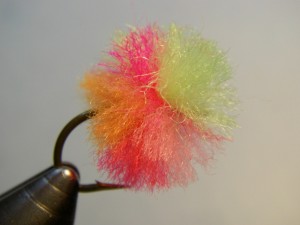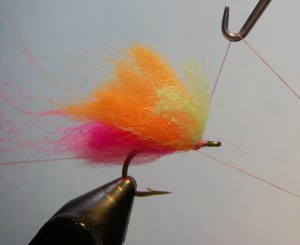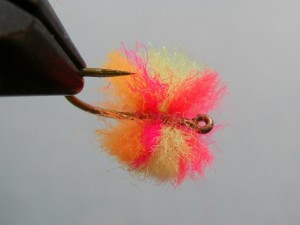The Rag style egg is a pattern tied loosely which is quite a departure from the very solid Glo Bug. It is translucent and shows multiple colors in a very organic way which is in part why it is so effective at representing eggs in various stages. This rag style also tends to sink when wet as opposed to floating or staying suspended like some of the solid egg patterns tied tightly with egg yarn.
The following directions are for a clown style rag egg, but colors and combinations are endless. Play around and see what works best for you.
Some of my personal favorite combinations are: Oregon Cheese and Steelhead Orange, Egg and Sockeye, Oregon Cheese, Chartreuse, Pink Lady, Steelhead Orange and Egg, Flame and Steelhead Orange (Light Clown).
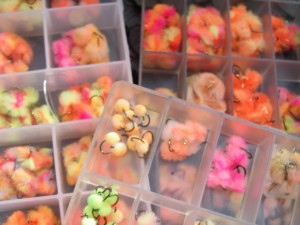 Note: When using this rag pattern suspended off of the bottom under floats, I prefer to tie with Daiichi 1640 #6 hooks as they are a little lighter wire but still strong enough for bringing fish to the net.
Note: When using this rag pattern suspended off of the bottom under floats, I prefer to tie with Daiichi 1640 #6 hooks as they are a little lighter wire but still strong enough for bringing fish to the net.
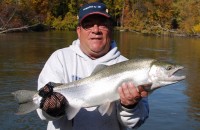
Dark Clown Rag Egg Recipe
Hook: TMC 105 # 6-10 or Gamakatsu C14S
Thread: Uni 6/0 – Color of Choice
Egg Yarn: Chartreuse, Steelhead Orange, Cerise, Flame, Shrimp Pink
Tying Instructions
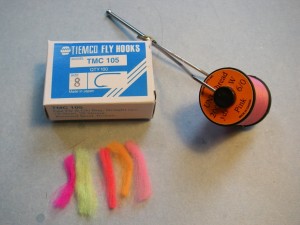 Step 1. Cut 1 ¼” pieces of yarn in the various colors and remove parts of the yarn as a full
Step 1. Cut 1 ¼” pieces of yarn in the various colors and remove parts of the yarn as a full
piece of egg yarn is too much. The amount of yarn varies and depends on hook size and the
amount of translucency desired. A starting point for size 8 hooks is to use just a little less than
the diameter of a pencil. If you want one color to be more prominent, use more of it and less of another.
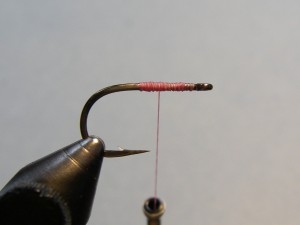 Step 2. Once hook is in the vise, wrap a thread base from behind the eye to above the hook point.
Step 2. Once hook is in the vise, wrap a thread base from behind the eye to above the hook point.
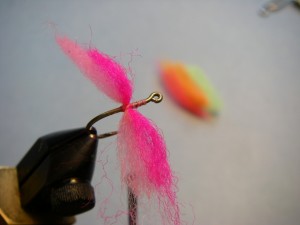 Step 3. Separate 2 colors (typically the bolder ones) of yarn and lay them perpendicular
Step 3. Separate 2 colors (typically the bolder ones) of yarn and lay them perpendicular
to the hook shank and tie in a crisscross manner similar to tying lead dumbbell eyes.
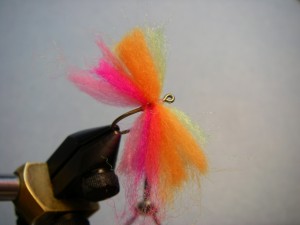 Step 4. Advance the thread in front of the yarn and tie in the remainder of the yarn in the same fashion.
Step 4. Advance the thread in front of the yarn and tie in the remainder of the yarn in the same fashion.
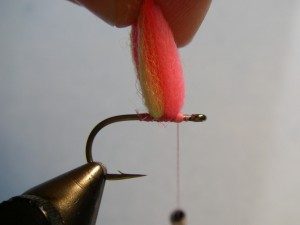 Step 5. Pull all of the thread up and put a small ball of thread just in front of the yarn.
Step 5. Pull all of the thread up and put a small ball of thread just in front of the yarn.
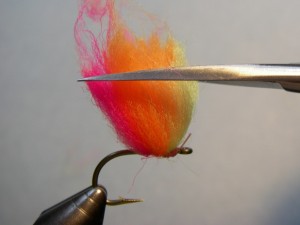 Step 7. Pull (not shown) the yarn upward and trim. The length depends on how dense
Step 7. Pull (not shown) the yarn upward and trim. The length depends on how dense
you want the pattern. A good rule of thumb is the size of the hook gape or a little less.
Step 8. Fluff the yarn with your fingers and you should have the finished fly in your hands.

